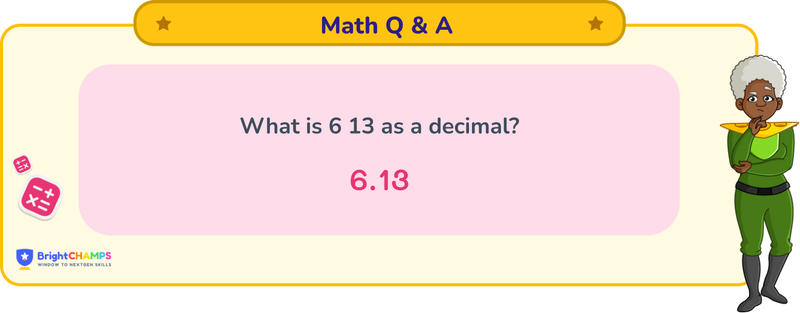
 158 Learners
158 LearnersLast updated on May 26th, 2025

6/13 as a decimal

It is a simple question on decimal conversion. Firstly, we have to learn fractions and decimals. A fraction represents a part of the whole. It has two parts: numerator (number on the top) here, 6 represents how many parts out of the whole. The denominator (number below) shows how many parts make the whole; here, it is 13. A decimal is a way to represent a number that is not whole, using a decimal point (.) to separate the whole part from the fractional part. The numbers to the left of the decimal point represent the whole, and those to the right represent the fractional part.
What is 6/13 as a decimal?

Answer
6/13 in decimals can be written as approximately 0.461538. It is a non-terminating, repeating decimal.
Explanation
To get 6/13 in decimal form, we will use the division method. Since 6 is smaller than 13, we will use the decimal method to get approximately 0.461538. Let's see the step-by-step breakdown of the process:
Step 1: Identify the numerator and denominator because the numerator (6) will be taken as the dividend and the denominator (13) will be taken as the divisor.
Step 2: As 6 is smaller than 13, it can't be divided. Here, we will take the help of decimals. We will add 0 to the dividend, which will make 6 as 60 and add a decimal point in the quotient place.
Step 3: Now that it is 60, we can divide it by 13. Let's see how many times 13 fits into 60.
Step 4: 13 is not a multiple of 60, so we will look for the nearest number that is 13 × 4 = 52. We will write 4 in the quotient place and subtract 52 from 60, which gives 8.
Step 5: Bring down another 0 in the dividend place, making 8 as 80, and then repeat the division process. The division process continues, and we find the repeating pattern 461538 in the decimal.
The answer for 6/13 as a decimal will be approximately 0.461538.
Struggling with Math?
Get 1:1 Coaching to Boost Grades Fast !

Important Glossaries for 6/13 as a decimal
- Fraction: A numerical quantity that is not a whole number, representing a part of a whole.
- Decimal: A number that uses the base ten and includes a decimal point to separate the whole part from the fractional part.
- Numerator: The top part of a fraction, indicating how many parts of the whole are being considered.
- Denominator: The bottom part of a fraction, showing how many parts make up a whole.
- Repeating Decimal: A decimal in which a pattern of one or more digits repeats infinitely.




